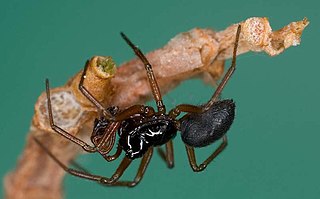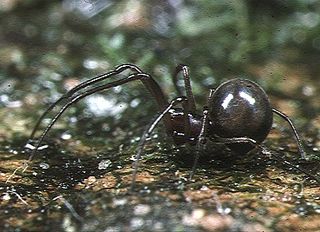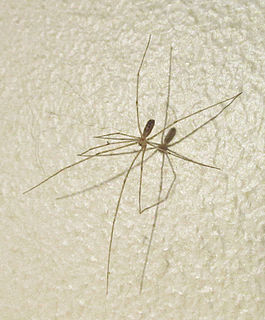
Desidae is a family of spiders, some of which are known as intertidal spiders. The family is named for the genus Desis, members of which live in a very unusual location — between the tides. The family has been reevaluated in recent years and now includes inland genera and species as well, such as Badumna and Phryganoporus. In 2017, the family Amphinectidae was merged into Desidae. The family Toxopidae has been separated off. Those intertidal spiders that are truly marine commonly live in barnacle shells, which they seal up with silk; this allows them to maintain an air bubble during high tide. They emerge at night to feed on various small arthropods that live in the intertidal zone.

Erigoninae are the largest subfamily of sheet weavers (Linyphiidae), which is itself the second largest spider family. In the United States they are known as dwarf spiders, while they are called money spiders in England. The exact taxonomic limits of the subfamily are not yet known.

Eugène Louis Simon was a French naturalist who worked particularly on insects and spiders, but also on birds and plants. He is by far the most prolific spider taxonomist in history, describing over 4,000 species.
Hyetussa is a genus of the spider family Salticidae.
Pignus is a genus of African jumping spiders that was first described by Wanda Wesołowska in 2000. As of August 2019 it contains only three species, found only in Africa: P. lautissimum, P. pongola, and P. simoni.

Anapidae is a family of rather small spiders with 231 described species in 58 genera. It includes the former family Micropholcommatidae as the subfamily Micropholcommatinae, and the former family Holarchaeidae. Most species are less than 2 millimetres (0.079 in) long.

Psilochorus is a genus of spiders in the family Pholcidae.
Pulchellodromus simoni is a spider species found in Portugal, Spain and Algeria.
Spermophorides simoni is a cellar spider species found in Corsica.

Metaltella simoni is a species of spider, native to South America, and introduced into the United States and Canada.

Metaltella is a genus of South American intertidal spiders first described by Cândido Firmino de Mello-Leitão in 1931. One species, Metaltella simoni, has been introduced to North America.
Pignus simoni is a species of jumping spider in the genus Pignus. It is native to South Africa.
Atypena ellioti is a species of spider of the genus Atypena. It is endemic to Sri Lanka.
Atypena is a genus of Asian dwarf spiders that was first described by Eugène Louis Simon in 1894.
Carpathonesticus simoni is an araneomorph spider species of the family Nesticidae. It occurs in Romania, where it can be found in caves. It was transferred from the genus Nesticus to Carpathonesticus in 1980 by Lehtinen and Saaristo.
Paro simoni is a species of Spanish dwarf spiders. It is the only species in the monotypic genus Paro. The species and genus were first described by Lucien Berland in 1942, and has only been found on the Austral Islands. Originally placed with the Agelenidae, it was moved to the sheet weavers in 1967.

Psilochorus simoni is a species of cellar spider in the family Pholcidae. It is found in the United States, has been introduced into Europe, Turkey, and New Zealand.

Calathotarsus simoni is a species of spider in the family Migidae, found in Argentina. Typical to the trapdoor families of spiders, rather than build nests, this spider creates burrows hidden by a door constructed of nearby detritus camouflaging its location.
Trite simoni is a jumping spider species in the genus Trite. It was first identified in 2014 by Polish arachnologist Barbara Maria Patoleta.







